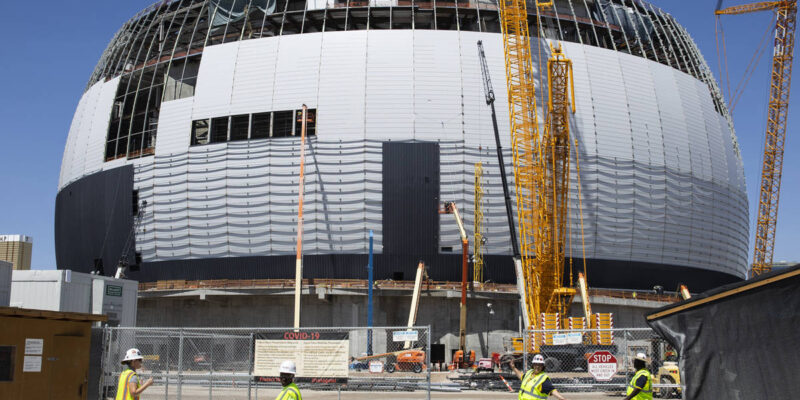2024 is a great year for sports: from the recent San Francisco vs. Kansas City Super Bowl rematch to the upcoming Summer Olympics, we’re primed and ready to yell at the TV root for our favorite athletes.
Of course, working at Steadfast Entities LLC, we’re also paying attention to the construction of the stadiums where the sports are played. Here are a few of the biggest sports infrastructure projects finishing up this year. We can’t wait to see the final results!
1. Los Angeles Stadium at Hollywood Park (SoFi Stadium)
Location: Inglewood, California, USA
Estimated Cost: Over $5 billion
The Los Angeles Stadium at Hollywood Park, dubbed SoFi Stadium, is an architectural marvel. Its sweeping canopy roof, spanning over 19 acres, creates an awe-inspiring spectacle, while the Oculus—a 70,000 square-foot, double-sided video board—promises an unparalleled viewing experience. With sustainability at its core, SoFi Stadium boasts a host of eco-friendly features, including a rainwater capture system and solar panels, solidifying its status as a beacon of modern sports architecture. While it is mostly completed, it is installing retractable corner seats that will expand the field for soccer games, an important upgrade since Sofi will be the home of the 2026 World Cup. The construction should be completed by May of 2024.
2. Paris 2024 Summer Olympics Infrastructure
Location: Paris, France
Estimated Cost: Billions
With the eyes of the world turning to Paris for the 2024 Summer Olympics, the City of Light is undergoing a remarkable transformation. From the iconic Stade de France to the futuristic Aquatics Center, Paris is poised to showcase its architectural prowess on the global stage. These state-of-the-art venues, designed to host a wide array of sporting events, embody France’s commitment to sustainability and inclusivity. As Paris prepares to welcome athletes and spectators from around the world, these venues stand as testaments to the enduring power of sport to unite and inspire.
3. Nashville Fairgrounds Stadium
Location: Nashville, Tennessee, USA
Estimated Cost: Over $275 million
Nashville’s vibrant music scene is about to be joined by the thunderous roar of crowds as the city welcomes its new Fairgrounds Stadium. Designed to be the home of Nashville SC, the city’s Major League Soccer team, this state-of-the-art venue promises to be a hub of excitement and entertainment. With a seating capacity of over 30,000 and a stunning canopy roof, the Nashville Fairgrounds Stadium will provide fans with an unforgettable experience rain or shine. More than just a sports venue, it will serve as a gathering place for the community, hosting concerts, festivals, and other cultural events.
4. Milan-Cortina 2026 Winter Olympics Infrastructure
Location: Milan and Cortina d’Ampezzo, Italy
Estimated Cost: Billions
Italy’s storied sporting legacy takes center stage once again as Milan and Cortina d’Ampezzo prepare to host the 2026 Winter Olympics. From the Alpine slopes of Cortina to the urban landscapes of Milan, a flurry of construction activity is underway to ensure that these historic cities deliver an unforgettable sporting extravaganza. With venues ranging from the iconic San Siro stadium to the picturesque mountains of the Dolomites, Italy’s passion for sports and culture will be on full display. As the world eagerly anticipates the 2026 Winter Games, Italy stands poised to showcase its unique blend of tradition, innovation, and hospitality on the global stage.
5. Brisbane Live Entertainment Arena
Location: Brisbane, Australia
Estimated Cost: Over $2 billion
Brisbane’s skyline is set to be transformed with the construction of the Brisbane Live Entertainment Arena. This world-class entertainment precinct, situated in the heart of the city, will feature a state-of-the-art arena capable of hosting major sporting events, concerts, and cultural performances. With a seating capacity of over 17,000 and cutting-edge audiovisual technology, the Brisbane Live Entertainment Arena promises to be a magnet for both local and international talent. As Brisbane cements its reputation as a dynamic cultural hub, this iconic venue will take center stage, drawing visitors from far and wide.
The completion of these areas in 2024 marks not only a triumph of engineering and design but also a celebration of the unity, resilience, and power of sports to inspire us all. As we appreciate the complexity of these stadiums and arenas, let’s also reflect on the values they represent—teamwork, determination, and the pursuit of excellence—in sports, at work, and in life.











